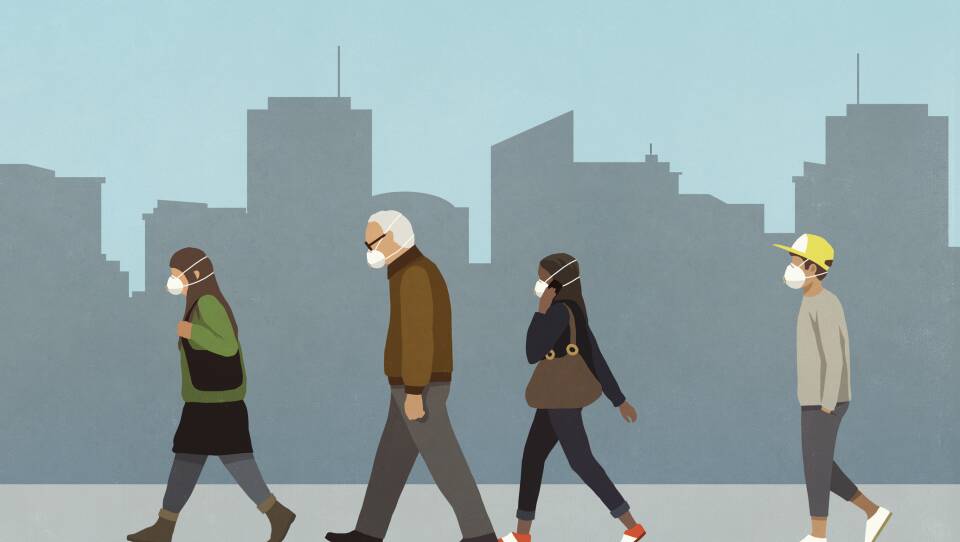Early in the COVID-19 pandemic, mask and protective personal equipment shortages were a major issue for frontline workers. A year in, the guidance for the public has evolved: cloth masks are good, double-masking may be better and N95s are the coveted gold standard. As it becomes clear that mask-wearing will be a lingering part of daily life even as more people get vaccinated, knock-offs continue to infiltrate the market.
One non-profit,Project N95, emerged as a platform to vet products, verify suppliers and help healthcare workers and others on the front lines get access to the PPE they need. Anne Miller, executive director of Project N95, joined Boston Public Radio on Tuesday to break down how to mask up.
The difference between N95, KN95 and KF94 masks
As highly transmissable COVID-19 variants spread, masks with higher filtration capabilities than cloth ones are becoming more popular. The N95 respirator is considered the gold standard in the medical world.
"An N95 is manufactured to U.S. standards," Miller said, "and it filters at greater than or equal to 95% [efficiency]."
KN95s are manufactured to Chinese standards, and KF94 masks are manufactured to South Korean standards. N95s and KN95s filter out at least 95% of particles; KF94 masks filter out at least 94% of particles.
How to tell if a mask is genuine
The FDA publishes a database of masks that have been cleared for emergency use authorization. Miller said there are more than 160 types and brands of masks on the list that have been approved for use by the government, and she starts her research there. The FDA also keeps a list of manufacturers whose approval has been revoked.
"Fundamentally, if you see it's on the FDA/EUA cleared list, then you know the government has said it's OK to be used in healthcare, and I think as a consumer you should feel OK wearing that one," she said. "The trick is, on a third party marketplace platform, there are people who say their mask is EUA cleared, when it isn't. Don't just take the sellers' word for it. Double check that the mask they say is EUA cleared is actually EUA cleared."
Miller also said a "dead giveaway" that the mask is a KN95 is that it has ear loops rather than a head strap.
For pleated surgical masks, Miller said to keep an eye out that they are manufactured to a standard ASTM Level 1 or higher.
"It should say the standard on the box," she said. "ASTM Level 1 or above, you know you're getting filtration efficiency."
Regardless of the mask, filtration and fit are the two words to keep in mind, said Miller. The mask should fit snugly over the nose and not have gape on the sides.
The latest on PPE supply
"In the begnning, there was a worldwide demand for masks," Miller said. "Over time we've seen the market stabilize. There's less world demand, there is more available supply and there's domestic supply. But we still see that healthcare workers aren't getting access to the PPE they need. That points to some sort of disconnect in the supply chain."
Miller said major hospital systems likely have the purchasing power to obtain the PPE they need, but the smaller community health clinics and other frontline workers are still having difficulty obtaining equipment.
"We're definitely producing more as a country, in terms of N95 respirators," Miller said. "I think the biggest challenge is this equitable distribution. We know people have surpluses of PPE and we know there are shortages, and it's trying to make that reallocation across the country to make sure people have what they need."
What mask should you get?
Miller said the increase in domestic supply and the way large hospital systems purchase PPE means that the general public should feel confident buying whatever mask they feel is right for them.
"When people who need it more than we do [go to buy masks and PPE], they're not buying it themselves," Miller said. "They're not buying the mask that we see at retail. They're buying them from large major wholesalers ... You shouldn't feel, when you're buying one, that you're taking away from them."
The value in double-masking
The CDC has recently come out with updated guidance on how to ensure proper mask fit, encouraging double masking with a surgical mask layered underneath a cloth mask.
"Wear that cloth mask, or whatever secondary mask (over a surgical mask) ... so you can get that side where it gaps. That's where the surgical mask has its limitations," Miller said.
"Fundamentally, a surgical mask is source control. That means than when you wear it, you're not spreading it to someone else," she said. "If we had 100 % compliance and everyone wore a surgical mask ... we'd have not much need for the double masking, because everyone would be source controlled."
"But we don't have everybody wearing surgical masks, and we don't even have everybody wearing masks, so we have to do more," she added. "Especially in the situation of the new variants, we need to be extra careful and have good fit and good filtration."
The CDC guidance explicitly recommends against combining two surgical masks or layering a KN95 mask with another mask.





